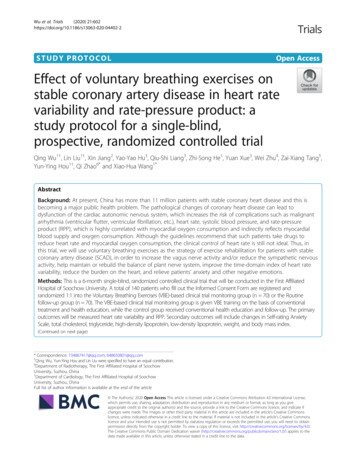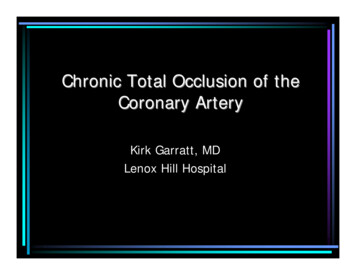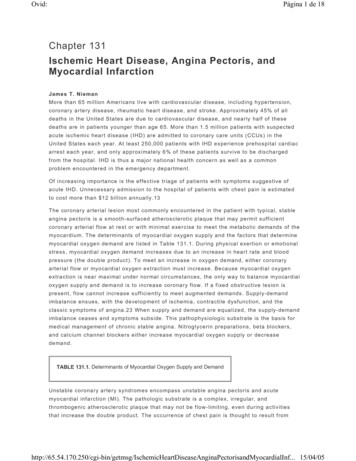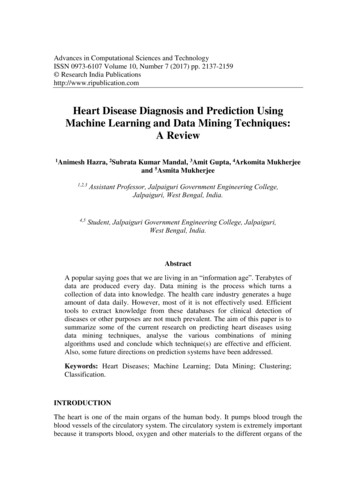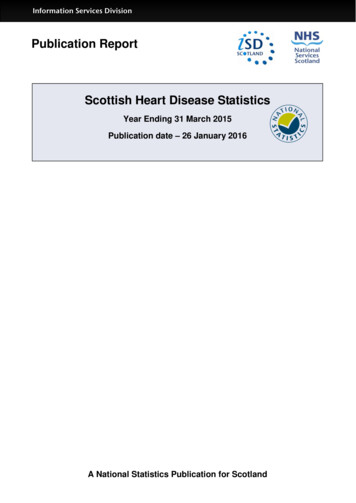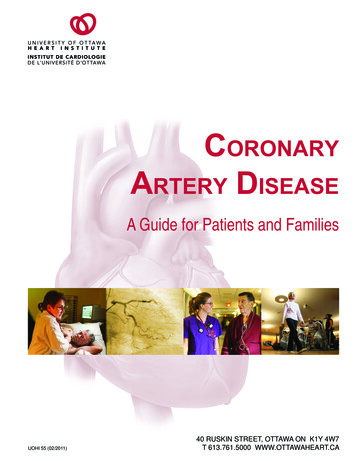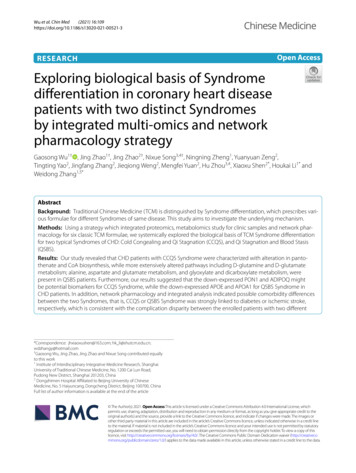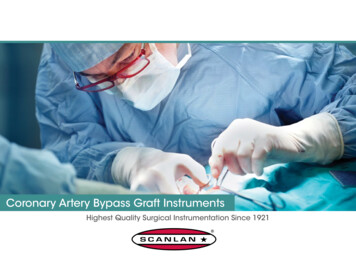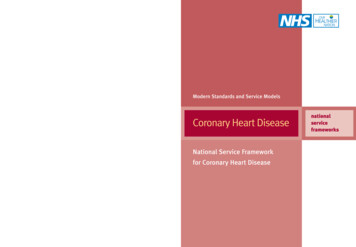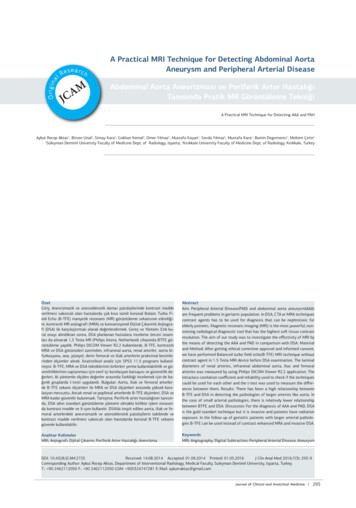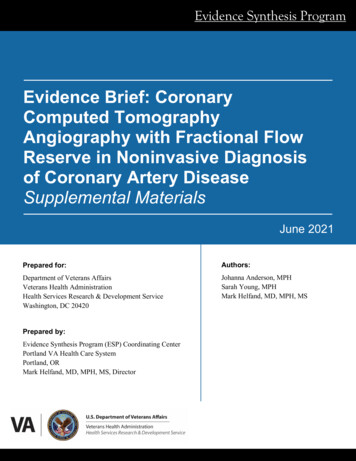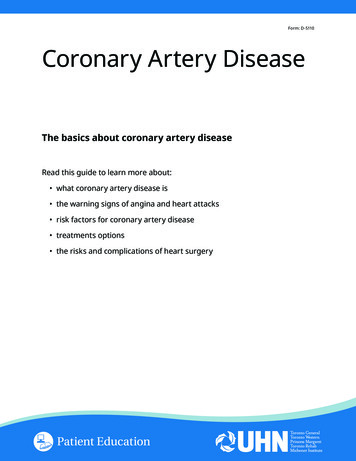
Transcription
Form: D-5110Coronary Artery DiseaseThe basics about coronary artery diseaseRead this guide to learn more about: what coronary artery disease is the warning signs of angina and heart attacks risk factors for coronary artery disease treatments options the risks and complications of heart surgery
What is coronary artery disease?Coronary artery disease happens when coronary arteries become narrowed.Sometimes layers of fat, also known as plaque, build up on artery walls. Thisis called atherosclerosis. When this happens, less blood flows through thearteries.Coronary arteries bring oxygen and nutrients to your heart muscle. If 75% ofyour coronary artery is blocked, your heart muscle may not get enough. Thisis called angina. This is a problem when your heart needs to work harder(for example, when you exercise).1
How will I find out if I have coronary artery disease?Doctors use different tests to help find out if you have coronary arterydisease. These tests usually take place in a hospital.Learn about all the tests by reading Chapter 3: Testing for Coronary ArteryDisease.What increases my risk of having coronary artery disease?These factors will increase your chances of having coronary artery disease: smoking high blood pressure high blood cholesterol (a type of fat in your blood) diabetes (high blood sugar) obesity (being overweight) stress family historyThese are also called risk factors for coronary artery disease.Why are risk factors important to know?You can lower your chance of getting heart disease if you remove a riskfactor. For example, if you quit smoking, you can lower your risk of gettingheart disease.If you already have heart disease, removing a risk factor will help slow it down.Read Chapter 5: Daily Life Guidelines. There you will learn how to loweryour risk.2
What are the symptoms (warning signs) of angina?You may have angina if you feel: pressure, a tightening, squeezing or cramping feeling in: your chest or arms your neck, jaw or throat your shoulders or back a burning feeling in your chest that may feel like heartburn out of breath or shortness of breathWhen might these symptoms happen?These symptoms might happen when: your heart is working harder than usual (for example, when youexercise) after eating when you do an activity such as walking in cold or windy weather when you are restingCall your family doctor or cardiologist right awayif you feel symptoms of angina: more often even when you are less active than usual even when you are resting3
What should I do if I feel the symptoms of angina?1. Stop what you are doing.2. Find your Nitroglycerine (NTG) pills or spray.3. Sit down.4. Take your Nitroglycerine (NTG) pill or spray. Follow the instructions onthe bottle.5. If your pain is still there 5 minutes later, take a second pill or spray.6. If your pain is still there after another 5 minutes, take a third pill or spray.Call 911 right away if: your pain does not go away within 5 minutes after taking thethird nitro pill or spray.After you call, unlock your front door. Sit or lie down and rest.Do not drive yourself.If you are with someone, have them drive you to the nearestemergency department.4
What is a heart attack?A heart attack happens when arteriesthat deliver blood and oxygen to theheart muscle become blocked. No bloodcan get to the heart muscle.A heart attack is also called myocardialinfarction, or MI. During a heart attack,plaque built up in the artery breaksopen. A blood clot forms on top of thispiece of plaque. This stops blood fromflowing through the artery. When thishappens, the heart muscle is damaged.What are the symptoms of a heart attack?Symptoms of a heart attack are like the symptoms of angina. For a heartattack, the symptoms last longer and are usually more severe.You might be having a heart attack if you have any of these kinds of feelingsor pain in your chest: Pressure tightness burning heaviness squeezing in the upper body lasting longer than 15 minutes5
Sometimes the symptoms listed above may feel mild. If you have some ofthese other symptoms as well, you may be having a heart attack: sweating nausea palpitations (your heart beating very fast) dizziness weakness trouble breathing (shortness of breath) vomitingCall 911 right away if you think you are havinga heart attack:After you call, unlock your front door. Sit or lie down and rest.Do not drive yourself to the hospital.If you are with someone, have them drive you to the nearestemergency department.What is the difference between a heart attack and angina?A heart attack and angina are different.When you have angina, there is no damage to the heart muscle.When you have a heart attack and you do not have timely interventions, partof the heart muscle dies. A scar forms on the muscle if a heart attack is nottreated right away.6
Treatment optionsHow is coronary artery disease treated?There is no cure for coronary artery disease. But, you can help slow thenarrowing of your arteries. You can do this by changing your risk factorslike smoking or being overweight.Other treatments may include: medicines angioplasty Aortocoronary Bypass (ACB) SurgeryEach of these treatments is explained in detail below.MedicinesMedicines are a common treatment for coronary artery disease.Some medicines control the symptoms of angina by relaxing thearteries. This helps to improve blood flow. More blood flow meansmore oxygen gets to the heart muscle.Other medicines slow your heart rate. When your heart beats slower,it is working less hard. If your heart is working less, it does not need asmuch oxygen.On the following page is a chart that gives some examples of medicinesthat can treat coronary artery disease.7
Name of medicineNitratesHow the medicine works opens up your blood vessels increases the amount of blood flow toyour heart prevents or treats chest painAspirinclopidogrel (Plavix )ticlopidine (Ticlid )prasugrel (Effient ) prevents platelets (clotting materialin your blood) from sticking togetherBeta Blockers slows your heart rate reduces your risk of having a heartattack decreases the amount of oxygenneeded by your heart decreases your blood pressureCalcium Channel Blockers opens up blood vessels to increaseblood flow to the heart may also slow your heart rate decreases your blood pressureCholesterol Lowering Agents lowers your cholesterol when diet andexercise are not enoughAngiotension converting Enzyme slows or prevents damage to the heart(ACE) inhibitorsmuscle following a heart attackAngiotension receptor blockers(ARB) may also reverse some damage decreases blood pressureRead Chapter 4: Cardiac (heart) Medicines to learn more about yourmedicines.8
What is Nitroglycerin ?Nitroglycerin is a medicine that relaxes your arteries.It helps to improve blood flow to your heart muscle.It comes in 2 forms — pill and spray.Each form of Nitroglycerin works in the same way.How to take Nitroglycerin pills1. Place the pill under your tongue.2. Let it dissolve or melt under your tongue.Do not swallow this pill! The pill is absorbed and works best when itdissolves (or melts) under your tongue.How should I store my pills? Throw out the cotton packing when you open a new bottle of pills. Store your Nitroglycerin tablets at room temperature. Keep the lid tightly closed. Keep the pills in the brown bottle that they came in. Throw out the pills 3 months after the bottle has been opened.It is a good idea to write the date to throw them out on the bottle.For example, if you opened the bottle on January 15, the date that you wouldwrite on the bottle is April 15.Always carry your Nitroglycerin pills with you.9
How do I use the Nitroglycerin spray?1. Hold the spray upright. Do not shake the spray.2. Remove the cover from your spray.3. Place your finger on the top of the button.4. Open your mouth. Bring the spray close to your mouth.5. Press the button firmly to release the spray. Aim for under your tongue orin the side of your cheek.Always carry your Nitroglycerin pills with you.How should I store my spray?Store your spray at room temperature.10
SurgerySometimes medicines may not work well for you. If this happens, yourdoctor may suggest one of these surgeries: Angioplasty Aortocoronary Bypass surgery (also called coronary artery bypass surgery)AngioplastyAngioplasty is a procedure that opens up the narrow or blocked arteriesin your heart. It is a treatment that can work well for people who have thisproblem.Angioplasty is a procedure for people with 1 or 2 blocked arteries. You donot need to go to an operating room for an angioplasty. Instead you go to ahospital department that is set up just for angioplasty.Read Chapter 7: Angioplasty to learn more about this procedure.Aortocoronary Bypass (ACB) surgeryYour doctor may suggest aortocoronary bypass (ACB) surgery if: medicines are working to control your symptoms your doctor is worried about the place where your artery or arteriesare narrowed11
ACB surgery increases blood flow to the heart muscle. This will relieve yoursymptoms and improve how your heart works.What happens during ACB surgery?1. During ACB surgery, your surgeon will bypass the narrow parts orblockages in your coronary arteries. Your surgeon will do this by using apiece of vein or artery from your own body.2. Your surgeon will use a piece of vein from your leg and/or an artery fromyour chest or wrist.3. If a leg vein is used, one end is sewn to the aorta. The other end is sewnto the coronary artery beyond the blockage.4. If a chest artery is used, one end is left attached to a branch of the aorta.The other end is sewn to the coronary artery below the blockage.5. Oxygen-rich blood can then flow through this new path called a bypassgraft to the heart muscle.12
How many bypasses will I have? The number of bypasses you have will depend on: the number of arteries affected the size of the artery or arteries beyond the blockage the condition of the artery or arteries beyond the blockage Some arteries cannot be bypassed. Your surgeon will talk to you aboutthis.Please note that the narrowed or blocked arteries are notremoved during ACB surgery.What will happen if I need open-heart surgery?Open-heart surgery usually takes from 3 to 4 hours to complete. Afterthe surgery, you go to an intensive care unit for 1 to 2 days. You will thenreturn to your hospital room. Most patients are in hospital for 5 to 8 daysrecovering from the operation.What are the risks of having heart surgery?The risks of heart surgery are not the same for everyone. Your risk willdepend on many factors, including: your age how severe your angina or other symptoms are if you have had a heart attack recently other health problems (such as kidney disease) that you have how healthy your heart muscle is whether your heart valves need to be repaired or replacedYour surgeon will explain all the risks you will have. Your surgeon will helpyou compare the risks of surgery with the risks of not having surgery.13
What are some possible complications (health problems)?Heart surgery is major surgery. Complications (problems) may happen.These complications may be small or large.Some complications that could happen are: problems with your heart rate This means you might need a pacemaker. A pacemaker is a littlemachine that keeps your heart beating at a regular pace. It will beplaced in your body and will stay there for the rest of your life. irregular heartbeat bleeding (internal or external) wound infection breathing problems heart attack, stroke or deathYour surgeon will explain all possible complications to you.Write any notes or questions here14
This resource was written by:Jeannine Costigan, RN, MScN, ACNPRuth Elias, MSc, RDJanice Jickling, RN, MScN, ACNPMin Hong, BSC. PharmJane MacIver, RN, MScNHeather Moon, BHSc OT Nicki Morris, BHSc PTDiane Neil-Pollinger, MSW, RSWPeter Nielsen, RN, BSCN, MNGraham Reid, PhDJohn Ross, MD, FRCPReviewed and revised by CICU Patient Education Committee, 2004Reviewed and revised by Zelia Souter (Nurse Manager), Pauline Glaves (PCC)and Rob Fuerte (APNE), 2014Reviewed by Nurse Manager 2020Have feedback about this document?Please fill out our survey. Use this link: bit.ly/uhn-pePaper and printing generously donated by Art Printing CompanyVisit www.uhnpatienteducation.ca for more health information. Contact pfep@uhn.ca to requestthis brochure in a different format, such as large print or electronic formats. 2020 University Health Network. All rights reserved. Use this material for your information only. It does not replace advice from yourdoctor or other health care professional. Do not use this information for diagnosis or treatment. Ask your health care provider for adviceabout a specific medical condition. You may print 1 copy of this brochure for non-commercial and personal use only.Form: D-5110 Author: Cardiology Reviewed: 04/2020
3. If a leg vein is used, one end is sewn to the aorta. The other end is sewn to the coronary artery beyond the blockage. 4. If a chest artery is used, one end is left attached to a branch of the aorta. The other end is sewn to the coronary artery below the blockage. 5. Oxygen-rich blood can then flow through this new path called a . bypass graft
